The Intel Skylake-X Review: Core i9 7900X, i7 7820X and i7 7800X Tested
by Ian Cutress on June 19, 2017 9:01 AM ESTBenchmarking Performance: CPU System Tests
Our first set of tests is our general system tests. These set of tests are meant to emulate more about what people usually do on a system, like opening large files or processing small stacks of data. This is a bit different to our office testing, which uses more industry standard benchmarks, and a few of the benchmarks here are relatively new and different.
PDF Opening
First up is a self-penned test using a monstrous PDF we once received in advance of attending an event. While the PDF was only a single page, it had so many high-quality layers embedded it was taking north of 15 seconds to open and to gain control on the mid-range notebook I was using at the time. This put it as a great candidate for our 'let's open an obnoxious PDF' test. Here we use Adobe Reader DC, and disable all the update functionality within. The benchmark sets the screen to 1080p, opens the PDF to in fit-to-screen mode, and measures the time from sending the command to open the PDF until it is fully displayed and the user can take control of the software again. The test is repeated ten times, and the average time taken. Results are in milliseconds.
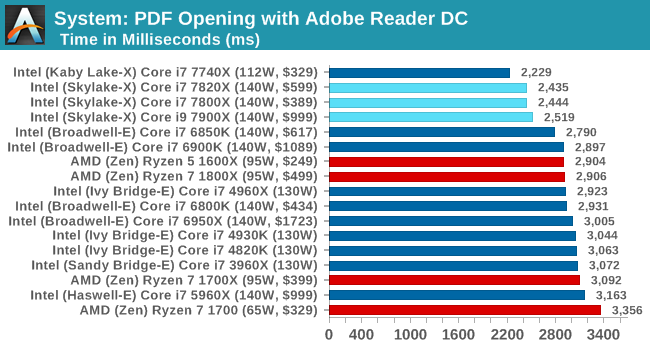
The extra frequency of the new processors is helping when it comes to opening our monster PDF, but also the extra L2 cache is likely having an effect as well.
FCAT Processing
One of the more interesting workloads that has crossed our desks in recent quarters is FCAT - the tool we use to measure stuttering in gaming due to dropped or runt frames. The FCAT process requires enabling a color-based overlay onto a game, recording the gameplay, and then parsing the video file through the analysis software. The software is mostly single-threaded, however because the video is basically in a raw format, the file size is large and requires moving a lot of data around. For our test, we take a 90-second clip of the Rise of the Tomb Raider benchmark running on a GTX 980 Ti at 1440p, which comes in around 21 GB, and measure the time it takes to process through the visual analysis tool.
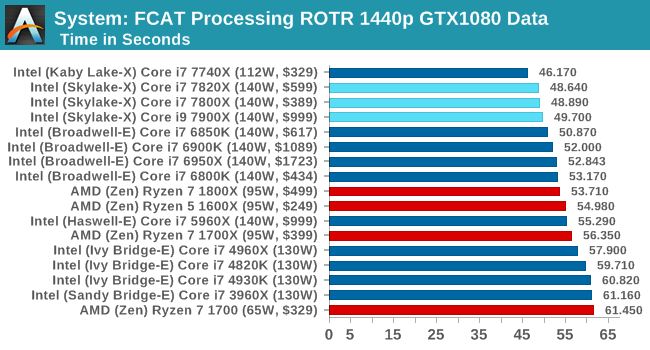
FCAT takes in a frame, processes it and dumps it, all on a single thread. The quicker you get through the workload the better, and frequency is supreme, hence we get the 7820X followed by the 7800X then the 7900X. Even though the 7900X has the higher turbo here, the results are with the margin expected.
3D Particle Movement v2.1
This is the latest version of the self-penned 3DPM benchmark. The goal of 3DPM is to simulate semi-optimized scientific algorithms taken directly from my doctorate thesis. Version 2.1 improves over 2.0 by passing the main particle structs by reference rather than by value, and decreasing the amount of double->float->double recasts the compiler was adding in. It affords a ~25% speed-up over v2.0, which means new data.
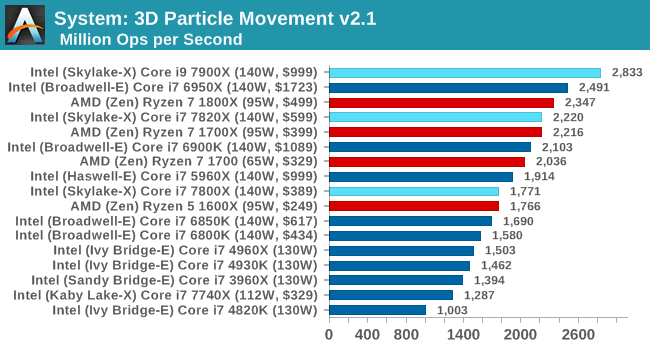
Give 3DPMv2.1 some cores, and it will show you the world / some numbers. The 1800X and 6950X were gunning for top spot, but the extra frequency of the 7900X wins here.
DigiCortex 1.20
Despite being a couple of years old, the DigiCortex software is a pet project for the visualization of neuron and synapse activity in the brain. The software comes with a variety of benchmark modes, and we take the small benchmark which runs a 32k neuron/1.8B synapse simulation. The results on the output are given as a fraction of whether the system can simulate in real-time, so anything above a value of one is suitable for real-time work. The benchmark offers a 'no firing synapse' mode, which in essence detects DRAM and bus speed, however we take the firing mode which adds CPU work with every firing.
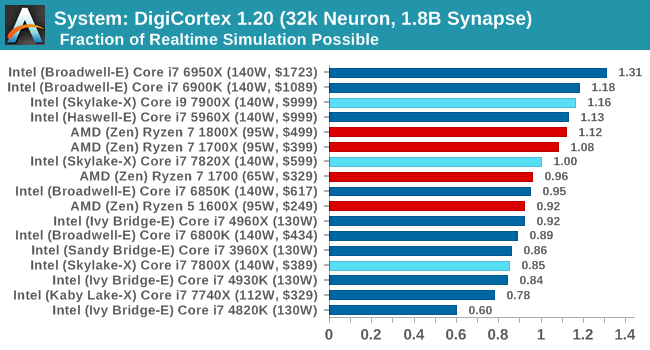
DigiCortex loves a bit of memory, although when speaking with the developer, there can some instances where the beast needs to be fed. Losing the inclusive L3 might be a factor here, especially with the 7800X all the way down.
Agisoft Photoscan 1.0
Photoscan stays in our benchmark suite from the previous version, however now we are running on Windows 10 so features such as Speed Shift on the latest processors come into play. The concept of Photoscan is translating many 2D images into a 3D model - so the more detailed the images, and the more you have, the better the model. The algorithm has four stages, some single threaded and some multi-threaded, along with some cache/memory dependency in there as well. For some of the more variable threaded workload, features such as Speed Shift and XFR will be able to take advantage of CPU stalls or downtime, giving sizeable speedups on newer microarchitectures.
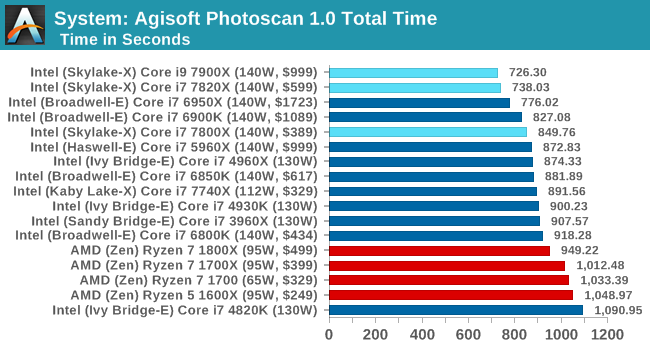
Photoscan is a mixed bag of operations, going through single thread sections to multithread and a range of cache/memory bandwidth requirepements. There's not much difference between thw 10 core and the 8 core, but the frequency helps against Broadwell-E.










264 Comments
View All Comments
FreckledTrout - Monday, June 19, 2017 - link
Missing the 7820x on the power draw graph.Ian Cutress - Tuesday, June 20, 2017 - link
The 7820X power numbers didn't look right when we tested it. I'm now on the road for two weeks, so we'll update the numbers when I get back.chrysrobyn - Monday, June 19, 2017 - link
In my head I'm still doing the math on every benchmark and dividing by watts and seeing Zen looking very different.Old_Fogie_Late_Bloomer - Monday, June 19, 2017 - link
I'm sure I'm wrong about this, but it makes more sense to me that the i9-7900X would be a (significantly) cut down HCC die instead of a perfect LCC. i9 vs i7, 44 vs 28 lanes, two AVX units instead of one?And yet the one source I've found so far says it's the smaller die. It's definitely the LCC die, then?
Ian Cutress - Tuesday, June 20, 2017 - link
HCC isn't ready, basically. LCC is. Plus, having a 10C LCC die and not posting a top SKU would be wasteful of the smallest die of the set.Also, delidding a 10C SKU.
Old_Fogie_Late_Bloomer - Tuesday, June 20, 2017 - link
Well, it wouldn't be a waste if Intel's yields weren't good enough to get fully functional dies. The fact that Intel is not just releasing fully functional LCC chips but announced that they would be the first ones available suggests that they have no trouble reliably producing them, which is pretty impressive (though they have had plenty of practice on this process by now).Thanks for the response; I thoroughly enjoyed the review and look forward to further coverage. Exciting times!
Despoiler - Monday, June 19, 2017 - link
Considering Ryzen is in the desktop category and these Intel chips are HEDT, we need to wait to see what Threadripper brings. AMD won't have the clock advantage, but for multithreaded workloads I suspect they will have more cores at a cheaper price than Intel.FreckledTrout - Monday, June 19, 2017 - link
I wouldn't say AMD wont have a clock advantage once you get to the 14 and 16 core chips. They might not but you saw the power numbers and thermals, Intel very well may have to pull back the frequency as they scale up the cores more than AMD will.FMinus - Thursday, June 22, 2017 - link
Actually I think it's the other way around. AMD might have clock advantage on higher core models thanks to not going with the monolithic approach. Easier to to cool those beasts but power is still an issue.If you imagine four 1800x on one interposer, you can see them reaching 4GHz on all of those dies, that said the power consumption would be massive, but easier cooler as the intel 16 core variant.
Lolimaster - Tuesday, June 20, 2017 - link
The 1995X will have a stock 3.6Ghz for the 16cores, same as the 7900X with just 10.